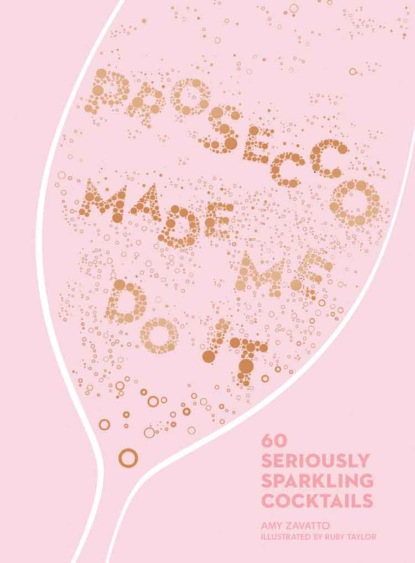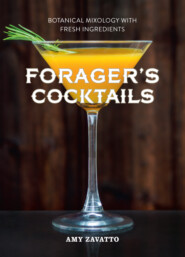По всем вопросам обращайтесь на: info@litportal.ru
(©) 2003-2024.
✖
Prosecco Made Me Do It: 60 Seriously Sparkling Cocktails
Настройки чтения
Размер шрифта
Высота строк
Поля
There is a third zone, however, that the Italian government gave an even more special designation: the Conegliano Valdobbiadene DOCG (denominazione di origine controllata e garantita). That G? That means, along with all the other assurances like specific region and grape, the government is guaranteeing the actual quality of what you’re about to drink. That’s pretty cool!
Another one of those DOC standards is the grape or grapes that can be used: Glera grapes, which, for a while, were also called Prosecco. (So if you thought Prosecco was the actual name of the grape, don’t feel bad.) All wines labelled as Prosecco must be made up of 85% of this Italian white grape variety, which is more often than not rife with beautiful orchard fruit notes. What’s the other 15%? About five or so other indigenous white varieties (if you really want to know: Glera Tonda, Glera Lunga, Glera Verdiso, Glera Perera and Glera Bianchetta Trevigiana), and, since the 1960s, four international grape varieties: Chardonnay, Pinot Grigio, Pinot Bianco and Pinot Nero (or Noir, as you may know it better).
There are three ways the DOC permits Prosecco producers to make their bubbly, but by and large what you buy from your favourite local wine shop or supermarket is in the spumante style, which is super bubbly (there’s also frizzante, with its more gentle bubbles, and a completely non-bubbly version, tranquilo).
THE DL ON THE DOCG
It’s worth taking a closer look at Conegliano Valdobbiadene, as it is a concentrated, unique little spot. I know – it’s super hard to say, so let’s begin with a little phonetic pronunciation lesson: cone-ell-yanno. Not so hard, right? Next up: val-doe-be-ah-den-ay. That one’s a little trickier. But if you practice a few times, it’ll start to roll around your tongue and out of your mouth like you’re a real Italian. And, you know, who doesn’t want to sound like a real Italian? I sure do.
Conegliano Valdobbiadene is a special place. It’s home to the birthplace of Prosecco wine, where the oldest vines dwell on dizzyingly steep south-facing slopes, and only the gentle human hand can carefully pick the fruit. Here, the vines are warmed by the sun and cooled by the breezes off the Adriatic Sea, and sit in diverse plots of land that make for beautifully nuanced sparkling wines. Grapes have likely been grown here for thousands of years, but it’s the late 20th century where things start getting really exciting for Prosecco.
In 1962, 11 local guys got together and said, you know, this place is pretty special! They formed the Consorzio di Tutela del Prosecco di Conegliano e Valdobbiadene. By 1969, the Italian government came around to agreeing (things take time in Italy – long lunches and all) and recognized the area as part of its special DOC system of quality.
But all along, Prosecco had been slowly but surely becoming more popular, thanks in part to Guiseppe Cipriani. Cipriani opened the famed Harry’s Bar near the Piazza San Marco in Venice in 1931. It was here that he created a cocktail that not only outlasted his own life, but perhaps will still be poured long after the sea claims Venice for its own: the Bellini (#litres_trial_promo). The irresistible mix of fresh white peach purée and Prosecco was a hit with both aristocrats and American soldiers stationed in Italy. They brought the drink to the US and, by the late 1960s, Prosecco began to appear in America; it had already crossed borders into other parts of Europe. Demand increased, and thus did production.
Fast forward to the noughties, and Glera growing and Prosecco making had spread far beyond the Congeliano-Valdobbiadene (C-V) borders into two full-on regions, nine provinces and 556 villages. Prosecco, you see, is prolific. Grapes were being planted in the valleys, where they grew fast and loose and harvesting could be done with quick-grabbing machines, allowing more, more, more Prosecco to fill glasses the world over. The problem with that: it diluted the quality. How could you tell the difference between a hand-harvested complex Prosecco from the C-V hills and a fast and loose fandango, machine-harvested in the valley? About 90 million bottles a year come from the DOCG zone, which is about 30 kilometres at its widest with around 7,000 hectares planted. So, that’s about one case of Prosecco per year for every person living in Amsterdam or Hong Kong. Lucky them! But compare that to 420 million bottles coming out of the greater DOC area and about 20,000 hectares, and you start to get the picture. This is why in 2009 the government awarded C-V the special status of DOCG. When you pick up a bottle, this will be clearly stated on the label, along with the word ‘superiore’, just for that extra-special emphasis. And for what it’s worth, just outside of the western tip of Conegliano Valdobbiadene is a little (just shy of 200 hectares) spot called Asolo, which is another separate Prosecco DOCG adhering to the same parameters and standards of quality that C-V does. But within C-V, things actually get even more wine-geeky, so let’s break it down …
Conegliano Valdobbiadene Prosecco Superiore
The oldest Prosecco producing spot, this DOCG was born (or, well, re-born) in 2009 to set its particularity apart from the rest of the Prosecco wines.
Rive
A super-special sub-zone designation, not unlike the villages of Burgundy. There are currently 43 in total. If you see this word along with Conegliano Valdobbiadene Prosecco Superiore, it means the grapes come only from the rive named on the label. The other cool thing about that: it positions you a little deeper into the region, letting you know if the grapes in your juice are from the more dense soils of Conegliano, which tend to give you a little more richness in texture, or the shallow, rocky soils of Valdobbiadene, rife with marine-deposits. Wines from here tend to have more prominent floral and minerally notes and, call me crazy, but a little bit of that seaside salinity, too.
Cartizze
Let’s just call this Prosecco Oz. It’s a single little 107-hectare area within Valdobbiadene in the western reaches of the DOCG.
SWEET (AND NOT-SO-SWEET) SENSATIONS
As you learned above, all Prosecco is not created equal. So it’s kind of funny how it got a rep for being sweet. Some are, sure, but certainly not all. How can you know? That’s easy. Regardless of where your Prosecco came from within the region (or the region within the region within the region!), every bottle has a wonderful, simple clue. If your bottle says:
Extra Brut
This designation is pretty new (made official as of 2017, although certainly wines had been made in the past at this level of dryness), and means there are between 0 and 6 grams of sugar in the final product. If you like your sparkly dry like a cracker, this for you.
Brut
This used to be the catch-all for extra brut, too, but now means you’re at a dry 6–12 grams of sugar. Nice and dry.
Extra Dry
At 12–17 grams of sugar, this might seem a little confusing. Shouldn’t ‘extra dry’ mean… extra dry? Maybe, but it doesn’t – it means the Prosecco in question has a nice easy-going bit of sweetness to it, but isn’t cloying or over-the-top. When you’re working with cocktails in which you want to play up the fruity essence in the drink, this is where you want to go.
Dry
At 17–32 grams of sugar, this not-so-dry sparkling is in the dessert zone. And if you don’t have any simple syrup or bar sugar on hand, it can be great to play around with if you need just that little bit of extra sweetness to balance out other more savoury or sour notes.
You’ll notice in the recipes that I steer you towards one or another of these sweetness levels. That’s worth paying attention to. Like any cocktail ingredient, you should consider what it brings to the final result. Some more juniper-heavy, herbaceous gins, for instance, make for an excellent Martini, while other more citrus-forward versions are key to a refreshing gin and tonic. Opt for one sweet vermouth or another, and your Manhattan takes on a whole new dimension. Same with Prosecco.
TOP TIPS (#ulink_b7fa0950-6f79-5bdd-ad8d-0acc41f66bbf)
You now know how Prosecco came to be. You know where it’s from and the nuances of the region and can walk into any wine shop and pick like a pro! But before we jump into all the fun that’s to come, let’s go over a few basics to help set your Prosecco-cocktail concocting on a good path.
HOW TO OPEN A BOTTLE
Put that sabre away, and for the love of Pete, DO NOT ever launch a cork into the atmosphere. The former is for the pros and the latter is just a silly, dangerous thing to do, no matter how fun it might seem. When you hit your best friend in the eye with a cork powered by 2.5 bars of pressure, I guarantee they will not be happy with you.
So do this instead:
1. Set the bottle on a solid surface, like a worktop.
2. Grab a tea towel or kitchen towel.
3. Place the towel over the top of the bottle.
4. Grab the base of the bottle securely with one hand, and put the other hand over the top of the towel-covered cork section.
5. Gently twist until the cork is released.
That’s it. I swear, it’s really easy. You won’t lose tons of overflowing delicious Prosecco and no one gets hurt. No better way to get the party started right.
STORING YOUR WINE
Like any wine, store your Prosecco in a cool, dark, mildly humid place (like a basement, if you have one) on its side until you’re ready to chill it and use it. Do not store it or any other wine for the long term in the refrigerator – the opening and closing of the door makes for lots of up and down in temperature and its just too dry of an atmosphere for the long haul with any wine. Definitely do not store your bottles on top of the refrigerator, or any high-up area – heat rises! Heat is the enemy of wine, and definitely the arch rival of bubbles.
When ready to use your Prosecco, pop it in the fridge a few hours or up to a day or so beforehand.
It might sound bananas, but if you don’t manage to finish an opened bottle (blasphemous!), use a simple Champagne stopper – these have a rubber seal that you press into the lip of the bottle and two side wings that fasten onto the rim. They’re inexpensive, easy to find and you can use them for beer and cider, too.
INGREDIENT CARE
Aside from spirits, cocktails require other ingredients, like fruits, herbs and sweeteners like syrups.
When it comes to fruit, the number one rule: always wash it! By wash, I mean rinse thoroughly with cool water. That goes for citrus, especially if you’re using the zest as a garnish. With raspberries and blackberries, only gently rinse what you need – washing all of them at once and putting back the brunt that isn’t going to go in your cocktail will lead to mouldy fruit. All those little bumps and nooks and crannies hold the moisture and, thus, start to rot faster when wet. Blueberries and strawberries are an exception, but you should let them dry off on a towel before putting them back in your refrigerator.
As for herbs, gently rinse and pat dry. Store any extra like flowers with the stems in a container of water, or dampen a paper towel, wrap them up and store in the crisper of your refrigerator.
SYRUPS (#ulink_d1346fbb-1434-5ba5-a590-ca6f107e6026)
Many cocktails in this book require a touch of simple syrup. I prefer using this to caster sugar or any granulated sugar, no matter how fine, because it’s already dissolved and easier to mix with. Make a batch ahead of time and store it in your refrigerator. The variations you can make on this are only limited by your imagination and ingredients, but here are the recipes contained in this book for your reference.
SIMPLE SYRUP
The basic recipe tells you a lot about the name:
it’s simple! The method is as follows:







